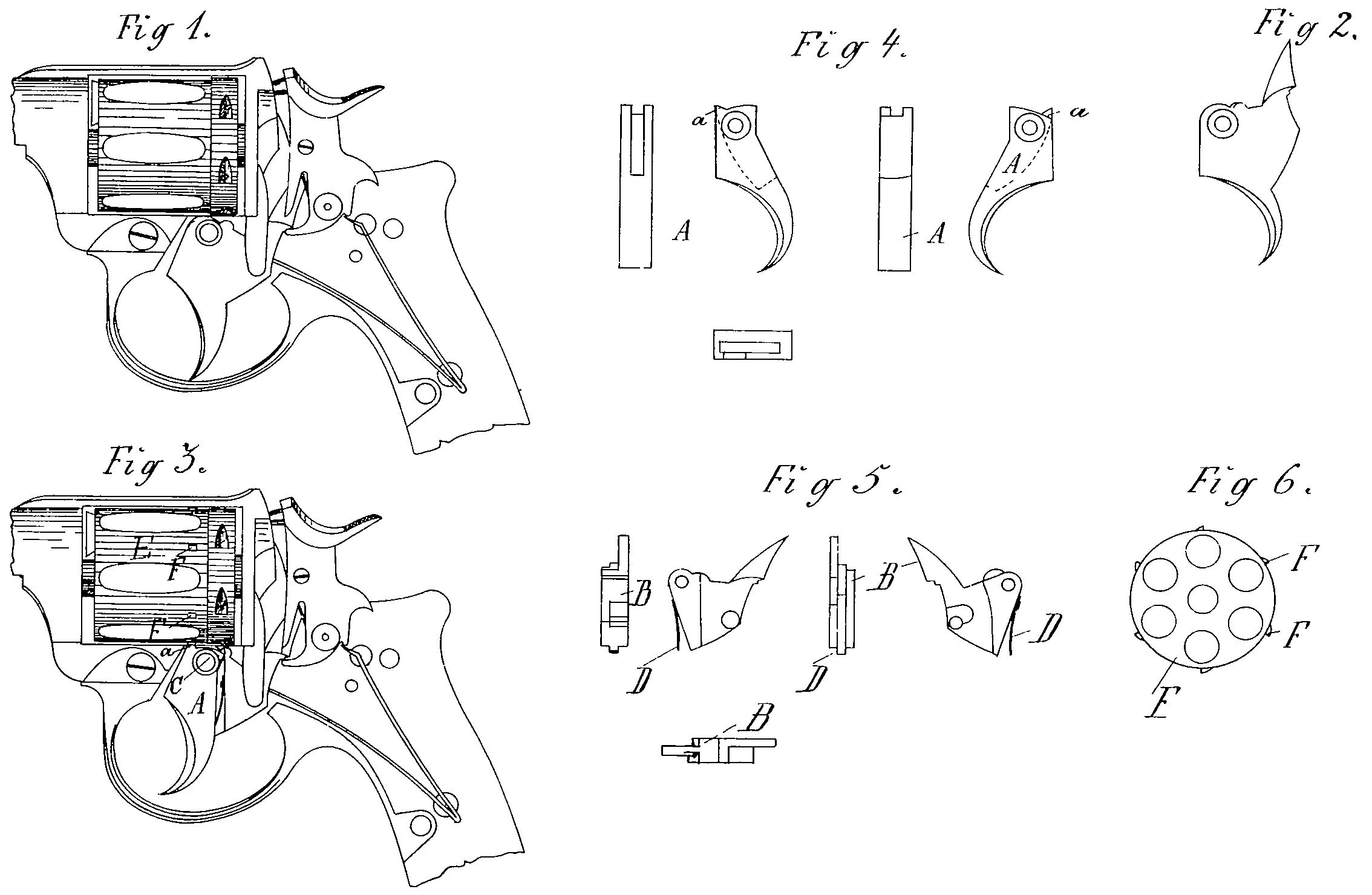Britain 8331
A.D. 1888, 7th June. № 8331.
COMPLETE SPECIFICATION.
Improvements in or relating to Revolvers.
I, Tor Fabian Tornell of Carlsborg in the Kingdom of Sweden, Lieutenant do hereby declare the nature of this invention and in what manner the same is, to be performed, to be particularly described and ascertained in and by the following statement :—
In the construction of some common revolvers, the breech-piece may freely turn round in one direction between each firing of the weapon, and thus it may inadvertently get into such a position, that when using the revolver, the hammer may instead of discharging the revolver, bit a cartridge which has already been fired. This, it will be understood, is a great inconvenience inherent to the construction of such revolvers. Another inconvenience 1s that there is nothing to prevent the hammer being inadvertently raised by striking or getting into contact wit something , owing to this fatal accidents may happen.
The revolver represented in Figure 3 of the annexed drawing 1s an example of a modification or improvement of the revolver shewn in Figure 1, and has for its constructed in accordance with this invention, and Figure 6 a section of the breech-piece or cylinder. For the sake of comparison, Figures 1 and 2 represent a revolver and trigger without my improvements, which construction may (as will be seen from the drawing) be easily altered so as to produce a revolver in accordance with this invention.
The trigger of a revolver disposed according to this invention is made 1n two parts, a fore part A, the trigger properly so called, and a hind part B, see Figures 3, 4 and 5. These two parts are pivoted on the same pivot C, which 1s preferably effected in such a way, that the one part 1s provided with a slot and the other part with a piece corresponding to and entering into the slot, the pivot holes passing through both parts when in position in a straight line. Between the said two parts a spiral or plate spring 18 adapted, (on the drawing a plate-spring D 1s represented) The spring may, however, be arranged differently, the object being to always separate the two parts as far from each other as the construction will allow, when the trigger is not being actuated, or when it is actuated to cause the parts to spring apart when the trigger 1s released. On the fore part of the trigger there 1s at a a projection or tooth, which, when the trigger is at rest, 1s pressed against the breech-cylinder or piece, E, of the revolver, the said breech cylinder having the same number of cams or pieces F, as there are charges in the breech cylinder. Those cams are so disposed that one of them always abuts or nearly abuts against the projection a on the fore part of the trigger, after the weapon has been fired. The breech-cylinder will thus be prevented by the tooth a from turning in one direction From being turned in the other direction it is hindered by the so-called rotator. The hammer cannot be cocked by directly pulling it, until the fore part of the trigger is drawn back a little by the finger, for m order to cock the hammer in this way it is necessary that the breech-piece be disengaged, so that the “rotator” can turn the same. By drawing the fore part of the trigger a little back, the hammer may be cocked by a direct pull at it, and the breech-piece may be turned at will in one direction. In cocking automatically the weapon is manipulated as usual.
Having now particularly described and ascertained the nature of my said invention, and in what manner the same is to be performed, I declare that what I claim is—
In revolvers, the means, substantially as described, for preventing the breech piece from turning between each firing of the weapon, which consists in the combination of a trigger formed in two parts, each pivoted on a common pivot and provided with a spring between them (the said parts being so made that the fore part can impart motion to the second part) and a breech piece having a series of cams or projections, of which always one (when the fore part of the trigger 1s at rest, and consequently pressed forward by the aforesaid spring) abuts or nearly abuts after the weapon 1s fired against a tooth on the fore part of the trigger, and thus prevents the breech piece from revolving.
Dated this 6th day of June 1888.
WM. P. THOMPSON & Co.,
Of 323, High Holborn, London,
Filing Agents for the Applicant.

